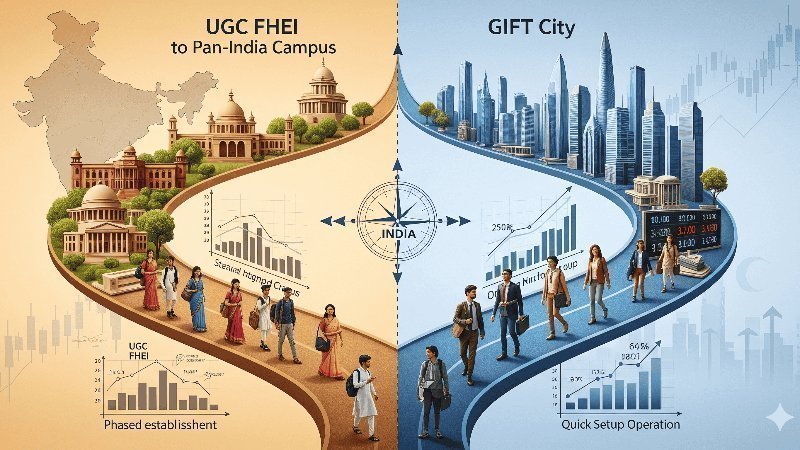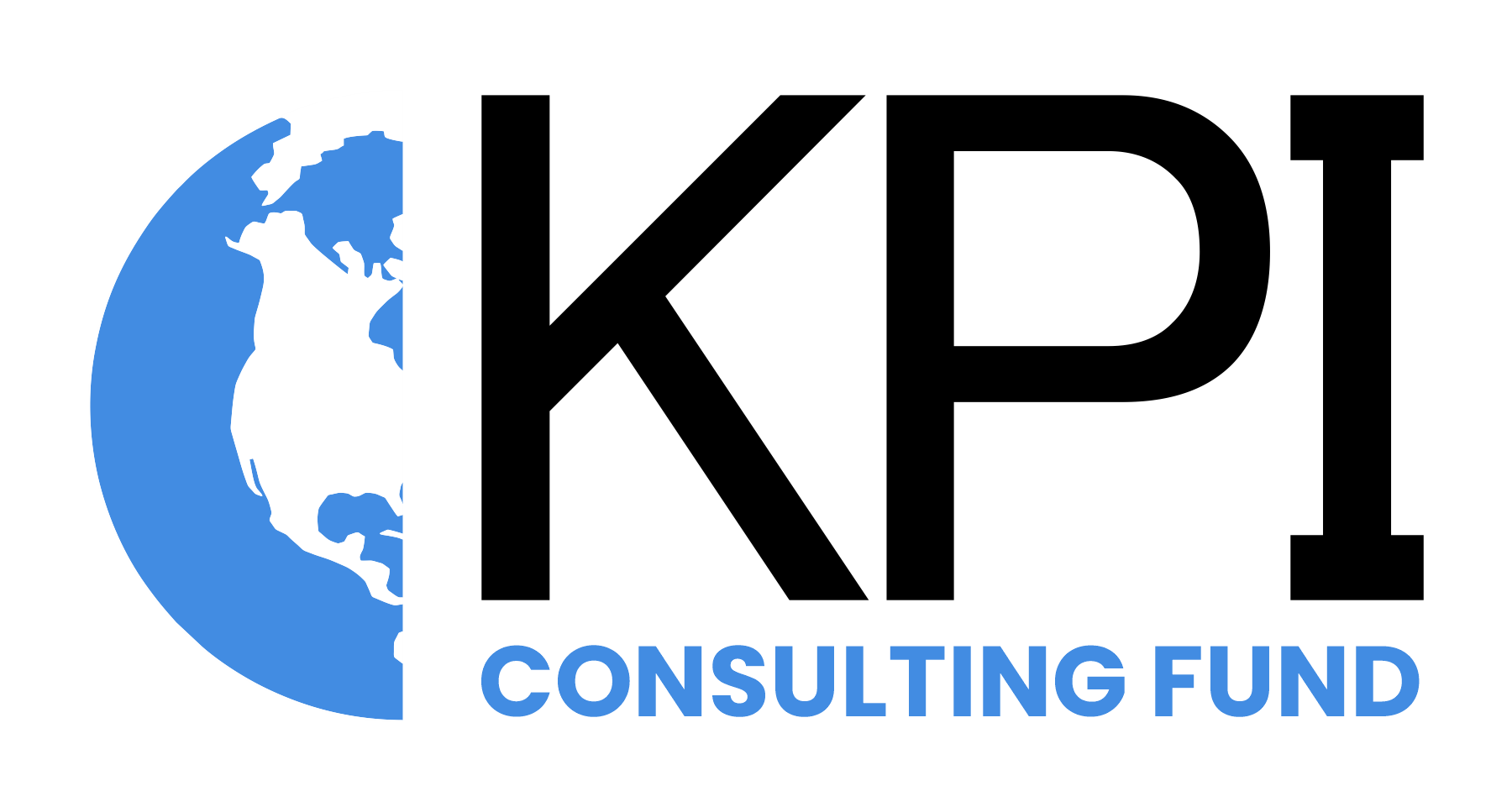
India Entry 2.0: A Guide for Foreign Universities
India now offers two credible entry ramps for foreign universities: UGC’s FHEI route (pan-India campuses) and GIFT City/IFSC units plus a phased collaborations-first path. Decide your posture (flagship parity campus vs. focused pilots), your regulatory on-ramp, and your time-to-first-cohort. Evidence-led sequencing (0–90d decision sprint; 3–9m proof points; 9-24m build) reduces approval and capex risk. Track academic parity, employer outcomes, and FX-aware unit economics monthly. Regulations codify offline delivery with up to 10% online lectures, two-stage approval culminating in perpetual approval, and degree equivalence. At the same time, GIFT offers clean FX and a 10/15-year tax holiday for eligible units. Done right, India entry becomes an outcomes win for students and employers.
What you need to decide now
Strategic posture. Are you building a flagship, parity-with-home campus or launching faster, focused programs to prove demand and employment outcomes first?
Regulatory on-ramp. Choose among three paths:
UGC FHEI (pan-India campus) for full academic breadth and lasting brand presence.
GIFT City/IFSC (Gandhinagar) for premium finance/data/tech master’s and executive education with clean FX, SEZ processes, and tax incentives.
Collaborations first (twinning/dual/joint) to validate price–demand–placement before committing capex.
Time-to-first-cohort and risk. Align the path with governance capacity, faculty mobility, and pre-secured employer commitments.
Why this matters (hard numbers).
Indian students in the U.S. reached 268,923 in 2022/23 (+35% YoY), signaling robust demand for Western-quality programs and outcomes.
UGC’s India-campus framework: offline delivery with up to 10% of lectures online, two-stage approvals (in-principle → final), and degree equivalence with the home campus.
GIFT/IFSC framework: purpose-built for finance/technology disciplines with IFSC regulation, foreign-currency operations, and tax holiday for 10 of the first 15 years (policy feature highlighted by ITA).
Choose your pathway (and when to use each)
UGC FHEI (pan-India campus).
Eligibility: Top-500 overall or subject-wise, or “special expertise.” Autonomy over curriculum, fees, admissions, scholarships, and faculty standards. Two-stage approval with final approval of perpetual duration; qualifications granted in India carry Indian equivalence. Best for multi-school footprints and research-teaching integration.
GIFT City / IFSC.
Operates under IFSCA (not UGC). Designed for finance/fintech/STEM-adjacent fields; programs must fall within permitted subject areas. Advantages include foreign-currency operations, SEZ processes, and ITA-noted 10/15-year tax holiday; use for speed, capital efficiency, and measurable outcomes.
Collaborations first (twinning/dual/joint).
A low-risk, high-signal ramp to test price points and pedagogy, build faculty mobility, and assemble parity evidence while developing employer networks and research links. (UGC has separately eased academic collaboration rules.)
—
A 12–24 month sequence you can defend
Phase 0 (0–90 days): Decision sprint
Compare paths using a Market–Reg–Ops–Finance matrix.
Produce a board brief with time-to-first-cohort, capex/opex envelope, FX/tax stance, and stop-loss triggers.
Phase 1 (3–9 months): Proof points
If GIFT: Launch 1–2 employer-co-designed programs; ring-fence P&L; measure yield, internship density, 90-day offer rate.
If Collaboration: Start 1–2 twinning/dual offerings; publish an assessment-parity map; stand up employer advisory councils.
Phase 2 (9–24 months): Campus build
If UGC: Finalize JV, site, and independent-campus specs; lock QA cadence, grievance redressal, and a reg-ops calendar; calibrate admissions and aid to metro affordability bands. (UGC notes no infrastructure sharing; campuses must use their own resources.)
Governance and KPIs your board will track
Academic parity. % of courses moderated by home campus; external QA findings cleared on time; faculty qualification parity and minimum tenure for visiting faculty (≥ one semester).
Funnel quality. Admit yield by price band; GRE/GMAT/portfolio mix versus targets.
Employer linkage. Internships per student, offer rate inside 90 days; advisory-board participation.
Unit economics. Net tuition per credit, instructional cost per credit, services cost per head, and FX-adjusted contribution.
Compliance rhythm: on-time filings (UGC/IFSCA), FEMA/FCRA attestations, and grievances closed within SLA.
Risks to plan around (not reasons to stall)
Eligibility and approvals. Top-500 thresholds and multi-agency approvals add friction; plan buffers and parallelize legal, academic, and facilities workstreams. Standing Committee timelines (recommendations targeted within ~60 days of complete application) help you stage-gate.
Modality and infrastructure. Offline delivery is the default; up to 10% of program lectures may be online. Plan timetables, services, and faculty mobility for on-ground delivery. No franchises/representative offices via the campus.
FX/tax posture (GIFT). Model sensitivity to rate moves and cohort ramps; align with IFSC rules and SEZ processes; use the 10/15 tax holiday judiciously.
What “good” looks like in practice
Product > presence. Start with 3–5 programs where you own a structural edge (faculty, labs, employer pull, assessment IP). Publish a parity map—learning outcomes, assessment, staffing - before the first cohort.
Pilots with proof. Use GIFT or collaborations to validate price–demand–placement and to generate audit-ready evidence for a UGC campus.
Govern for permanence. Treat QA, grievance redressal, and exchange-control compliance as standing operations (owners, templates, evidence locker), not one-off milestones.
Employer-embedded design. Lock internships, capstones, and advisory councils before launch; reputations follow outcomes at scale.
Affordability ladders. Price and aid should map to metro income tiers; track yield curves and adjust early based on Phase-1 data.
Why this matters now
India isn’t just a new market; it’s a new production function for higher education. The winners won’t copy-paste a brand abroad - they’ll co-produce talent with employers, co-author research with Indian faculty, and co-design affordability with policy. Done right, India entry becomes a student, sovereign, and employer win - and a resilient growth engine for your university.
If you’d like a board-ready go/no-go pack (decision matrix, KPI tracker, and regulatory calendar), ask for the 30-day decision brief template and we’ll tailor it to your constraints and ambitions.
Editorial note/disclaimer: This article is informational and not legal, tax, or investment advice. Regulations evolve; confirm specifics with counsel (UGC/IFSCA, FEMA/FCRA, and tax) before making commitments.
Sources
U.S. International Trade Administration — India: Education Services (CCG, last updated Jan 12, 2024). https://www.trade.gov/country-commercial-guides/india-education-services Trade.gov
University Grants Commission — FHEI portal FAQ (online lectures cap). https://fhei.ugc.ac.in/FAQ/Index fhei.ugc.ac.in
India Today (PTI) — UGC notifies regulations for foreign universities… (independent campus; timelines; 10% online). https://www.indiatoday.in/education-today/news/story/ugc-notifies-regulations-for-foreign-higher-education-institutions-to-set-up-campuses-in-india-2460730-2023-11-09 India Today
Khaitan & Co — India Opens Doors to Foreign Universities (two-stage → perpetual approval; degree equivalence; faculty parity; non-representative office). https://www.khaitanco.com/thought-leaderships/India_Opens_Doors_to_Foreign_Universities_A_Legal_Update_on_the_New_Foreign_University_Campus_in_India_Regulations Khaitan & Co
IFSCA — Setting up and Operation of International Branch Campuses and Offshore Education Centres Regulations, 2022 (subject areas; IFSC oversight). https://ifsca.gov.in/Legal/Index?MId=TpVDBbsrGYI%3D → “View Document” (PDF) ifsca.gov.in
Open Doors — India Fact Sheet 2023 (Indian students in the U.S.). https://opendoorsdata.org/wp-content/uploads/2023/11/OpenDoors_FactSheet_India_2023.pdf IIE Open Doors
FORVIS Mazars — Opportunities for Foreign Universities to Operate in India (summary of FHEI and GIFT options). https://www.forvismazars.us/forsights/2024/01/opportunities-for-foreign-universities-to-operate-in-india Forvis Mazars
QS — Setting up a campus in India: The ten-point plan. https://www.qs.com/india-international-branch-campus/
Strategic posture. Are you building a flagship, parity-with-home campus or launching faster, focused programs to prove demand and employment outcomes first?
Regulatory on-ramp. Choose among three paths:
UGC FHEI (pan-India campus) for full academic breadth and lasting brand presence.
GIFT City/IFSC (Gandhinagar) for premium finance/data/tech master’s and executive education with clean FX, SEZ processes, and tax incentives.
Collaborations first (twinning/dual/joint) to validate price–demand–placement before committing capex.
Time-to-first-cohort and risk. Align the path with governance capacity, faculty mobility, and pre-secured employer commitments.
Indian students in the U.S. reached 268,923 in 2022/23 (+35% YoY), signaling robust demand for Western-quality programs and outcomes.
UGC’s India-campus framework: offline delivery with up to 10% of lectures online, two-stage approvals (in-principle → final), and degree equivalence with the home campus.
GIFT/IFSC framework: purpose-built for finance/technology disciplines with IFSC regulation, foreign-currency operations, and tax holiday for 10 of the first 15 years (policy feature highlighted by ITA).
Eligibility: Top-500 overall or subject-wise, or “special expertise.” Autonomy over curriculum, fees, admissions, scholarships, and faculty standards. Two-stage approval with final approval of perpetual duration; qualifications granted in India carry Indian equivalence. Best for multi-school footprints and research-teaching integration.
Operates under IFSCA (not UGC). Designed for finance/fintech/STEM-adjacent fields; programs must fall within permitted subject areas. Advantages include foreign-currency operations, SEZ processes, and ITA-noted 10/15-year tax holiday; use for speed, capital efficiency, and measurable outcomes.
A low-risk, high-signal ramp to test price points and pedagogy, build faculty mobility, and assemble parity evidence while developing employer networks and research links. (UGC has separately eased academic collaboration rules.)
Compare paths using a Market–Reg–Ops–Finance matrix.
Produce a board brief with time-to-first-cohort, capex/opex envelope, FX/tax stance, and stop-loss triggers.
If GIFT: Launch 1–2 employer-co-designed programs; ring-fence P&L; measure yield, internship density, 90-day offer rate.
If Collaboration: Start 1–2 twinning/dual offerings; publish an assessment-parity map; stand up employer advisory councils.
If UGC: Finalize JV, site, and independent-campus specs; lock QA cadence, grievance redressal, and a reg-ops calendar; calibrate admissions and aid to metro affordability bands. (UGC notes no infrastructure sharing; campuses must use their own resources.)
Academic parity. % of courses moderated by home campus; external QA findings cleared on time; faculty qualification parity and minimum tenure for visiting faculty (≥ one semester).
Funnel quality. Admit yield by price band; GRE/GMAT/portfolio mix versus targets.
Employer linkage. Internships per student, offer rate inside 90 days; advisory-board participation.
Unit economics. Net tuition per credit, instructional cost per credit, services cost per head, and FX-adjusted contribution.
Compliance rhythm: on-time filings (UGC/IFSCA), FEMA/FCRA attestations, and grievances closed within SLA.
Eligibility and approvals. Top-500 thresholds and multi-agency approvals add friction; plan buffers and parallelize legal, academic, and facilities workstreams. Standing Committee timelines (recommendations targeted within ~60 days of complete application) help you stage-gate.
Modality and infrastructure. Offline delivery is the default; up to 10% of program lectures may be online. Plan timetables, services, and faculty mobility for on-ground delivery. No franchises/representative offices via the campus.
FX/tax posture (GIFT). Model sensitivity to rate moves and cohort ramps; align with IFSC rules and SEZ processes; use the 10/15 tax holiday judiciously.
Product > presence. Start with 3–5 programs where you own a structural edge (faculty, labs, employer pull, assessment IP). Publish a parity map—learning outcomes, assessment, staffing - before the first cohort.
Pilots with proof. Use GIFT or collaborations to validate price–demand–placement and to generate audit-ready evidence for a UGC campus.
Govern for permanence. Treat QA, grievance redressal, and exchange-control compliance as standing operations (owners, templates, evidence locker), not one-off milestones.
Employer-embedded design. Lock internships, capstones, and advisory councils before launch; reputations follow outcomes at scale.
Affordability ladders. Price and aid should map to metro income tiers; track yield curves and adjust early based on Phase-1 data.
U.S. International Trade Administration — India: Education Services (CCG, last updated Jan 12, 2024). https://www.trade.gov/country-commercial-guides/india-education-services Trade.gov
University Grants Commission — FHEI portal FAQ (online lectures cap). https://fhei.ugc.ac.in/FAQ/Index fhei.ugc.ac.in
India Today (PTI) — UGC notifies regulations for foreign universities… (independent campus; timelines; 10% online). https://www.indiatoday.in/education-today/news/story/ugc-notifies-regulations-for-foreign-higher-education-institutions-to-set-up-campuses-in-india-2460730-2023-11-09 India Today
Khaitan & Co — India Opens Doors to Foreign Universities (two-stage → perpetual approval; degree equivalence; faculty parity; non-representative office). https://www.khaitanco.com/thought-leaderships/India_Opens_Doors_to_Foreign_Universities_A_Legal_Update_on_the_New_Foreign_University_Campus_in_India_Regulations Khaitan & Co
IFSCA — Setting up and Operation of International Branch Campuses and Offshore Education Centres Regulations, 2022 (subject areas; IFSC oversight). https://ifsca.gov.in/Legal/Index?MId=TpVDBbsrGYI%3D → “View Document” (PDF) ifsca.gov.in
Open Doors — India Fact Sheet 2023 (Indian students in the U.S.). https://opendoorsdata.org/wp-content/uploads/2023/11/OpenDoors_FactSheet_India_2023.pdf IIE Open Doors
FORVIS Mazars — Opportunities for Foreign Universities to Operate in India (summary of FHEI and GIFT options). https://www.forvismazars.us/forsights/2024/01/opportunities-for-foreign-universities-to-operate-in-india Forvis Mazars
QS — Setting up a campus in India: The ten-point plan. https://www.qs.com/india-international-branch-campus/
